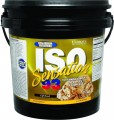Weight
The weight of the protein supplied in this packaging option (excluding packaging).
Knowing the amount of protein and the size of the daily portion, you can estimate how long this amount will last. And since different situations require a different supply of product, the same brand is often produced in several weight options. At the same time, larger packages, usually, are cheaper in terms of a kilogram of weight. However, it cannot be said unequivocally that it always makes sense to buy large volumes — for example, it is convenient to take a small package “for testing”, at the end of a training programme or for the duration of a trip if the main stock is left at home.
Note that many manufacturers traditionally tie the weight of their products to pounds: for example, the weight of 4.54 kg, popular among large cans and packages, corresponds to just 10 pounds.
Number of servings
The number of servings contained in this packaging option. For more on the meaning of the term "portion", see the relevant paragraph below; here we only note that the recommended serving size may differ from that indicated by the manufacturer, respectively, and the actual number of servings may be less or more than the claimed one. Nevertheless, according to this indicator, one can at least approximately estimate how long the package will last. The most modest packaging options include
up to 25 servings, in the largest this number can
exceed 100.
Serving
The size (weight) of a standard serving of protein; most often we mean a portion for one dose (there may be several such receptions per day). This indicator is indicated depending on the packaging features: for example, for products in individual packaging (bags), the weight of the contents in one bag is given.
Anyway, note that in the characteristics the manufacturer indicates a certain conditional portion, designed for a “standard” athlete and an average level of loads. In fact, the optimal serving size may differ markedly from the standard one depending on weight, metabolic characteristics, training programme, dietary specifics, etc. Detailed recommendations for such calculations can be found in special sources, but anyway, these calculations are based on the size of a standard servings claimed by the manufacturer.
Calorie portion
Calorie content per serving of protein (see "Serving").
Correct determination of the optimal number of calories and compliance with these requirements is an integral part of a complete sports nutrition. Accordingly, specialized sports nutrition, including proteins, necessarily contains information on calorie content. In general, higher calorie brands are useful mainly for weight gain, lower calorie brands for fat burning, although in fact a lot depends on the characteristics of the athlete and his training programme.
Country of origin
The country in which the protein was released. Quite close attention is often paid to this information: it is believed that products manufactured in highly developed countries like the
USA or
Germany are of the highest quality. However, this approach is largely incorrect, because different manufacturers can understand the term “country of production” in very different ways — to the point that it often means only the “homeland” of the brand, and the product is produced in completely different countries. This cannot be called an unambiguous deception: conscientious manufacturers usually carefully monitor the quality of their products and maintain the reputation of a “high-class American (German, etc.) brand” (especially since high-tech production, in compliance with the necessary standards, can now be deployed in any region) . On the other hand, coming from a less popular country does not in itself mean a less conscientious manufacturer. Therefore, in fact, the quality of the product is practically not related to the country of production, and it is worth paying attention to the reputation of a particular brand rather than its “origin”.

